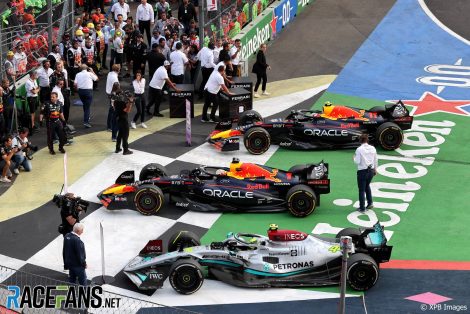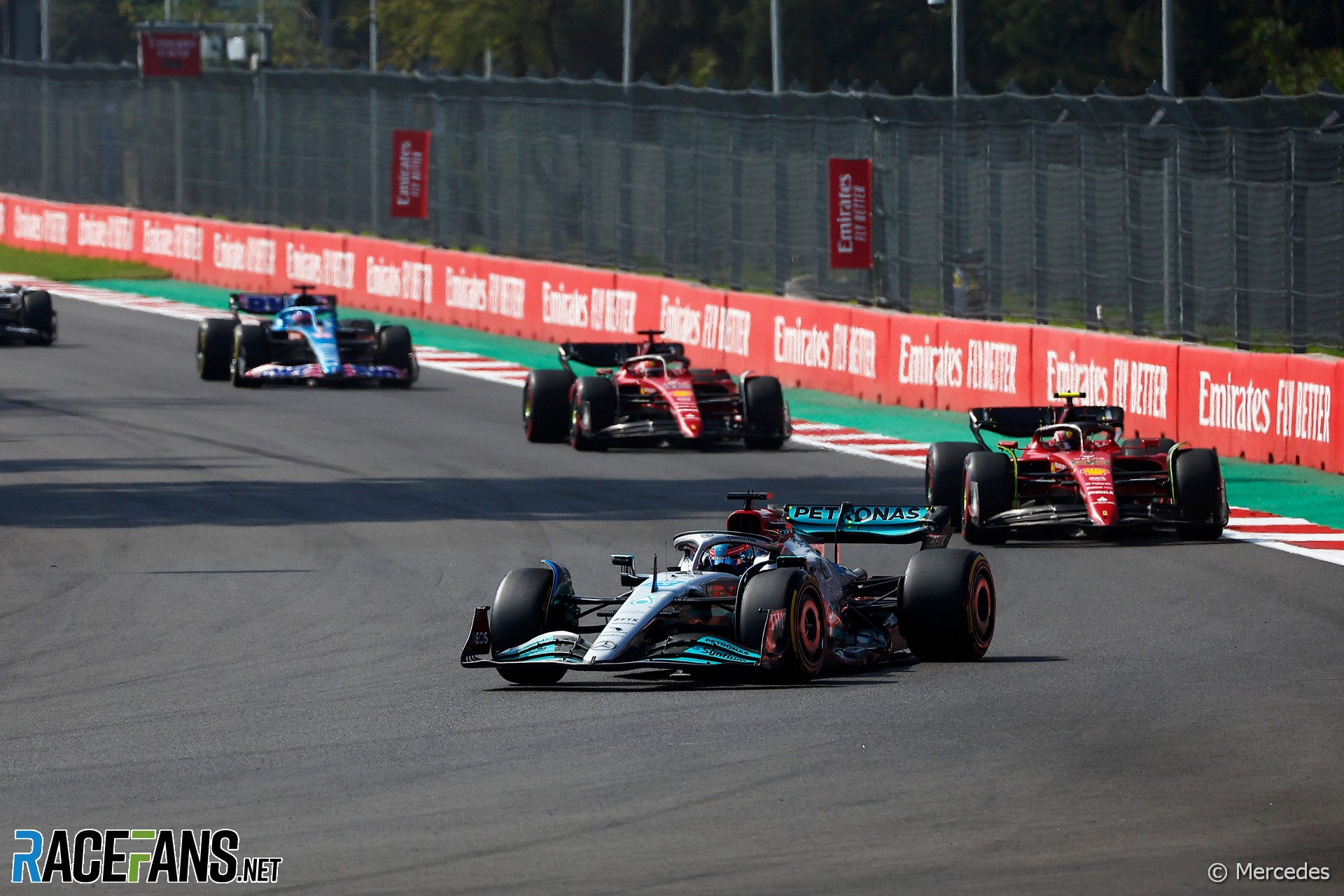The overhaul of Formula 1’s technical regulations for 2022 was supposed to make it easier for drivers to race close together by changing the aerodynamic profiles of the cars.
By reducing the amount of ‘dirty air’ created by the displacement of a moving vehicle, it would become easier for cars to stay in the wake of others and attempt overtakes. At several venues this season that has proved to be the case.But the high-altitude Mexico City track was an exception to the rule. Last weekend’s Mexican Grand Prix was another processional affair with the top six positions at the end of lap one being the same as at the finish.
Some drivers predicted this would be the case based on what they discovered in practice. There is less dirty air when the air is thinner at a higher altitude, but that means the slipstream effect is considerably weaker than at sea level. It also means there is less cool air which is critical for cars to travel through to control the temperatures of internal components.

Bottas’s team mate Zhou Guanyu had his first experience of the track and has surprised how little grip there was. “The track is so slippery. The surface, you are sliding a lot. For me to try to have that confidence in qualifying and also the race was tricky.”
During Zhou’s second stint he ended up stuck in a train of cars where, like Bottas, he could only spend so long running close behind those ahead before lowering his pace to manage temperatures.
Advert | Become a RaceFans supporter and
The slippery surface and lack of grip also his unhelpful implications for race strategies. “This circuit is quite a low tyre degradation circuit, very smooth surface, very low load, not a lot of high-speed content,” explained Aston Martin’s performance director Tom McCullough. “So historically has been very low degradation.

Sure enough drivers who ran on Pirelli’s soft tyre early in the race realised they could prolong their stints. The track surface proved kind to the rubber but tyre management still remained a concern when running in traffic due to the lack of cool air reaching other parts of the car. Without a steep degradation curve, there is a smaller difference in pace between drivers on new and old tyres.
“It’s a thermal race, and dirty air is terrible around here because the brakes get hot, that makes the tyres hot,” Williams’ Alexander Albon explained.
“Downforce is obviously off as well, and you really need clean air to look after the tyres. But everyone’s managing so much that you actually end up in this kind of processional race where everyone was just driving around managing tyres.”
Albon was one of few drivers to make some progress in the race, climbing from 17th on the grid to finish 12th.
Advert | Become a RaceFans supporter and
“We did well to find the gaps of clean air in our strategy. And actually, really what changed our race was being able to get past Sebastian [Vettel] because I think that enabled us to get the clean air on the tyres and keep pushing forwards.”

The first three were immediately after Sergio Perez’s pit stop, in which the Red Bull driver came out behind Ferrari’s Charles Leclerc and soon passed him. The other was in the second half of the race when Leclerc’s team mate Carlos Sainz Jnr reached Alonso who had prolonged his first stint.
Alpine pitted him on the next lap, and like many he spent the rest of the race also having to manage power unit temperatures. That stopped drivers from going on the attack, and in Alonso’s case a cylinder failure ultimately ended his race early.
The characteristics of F1 cars may have changed, but the characteristics of the circuit have not. Drivers will face the same problems each year, unless perhaps F1 follows Formula E in racing there during the colder period at the start of the year. Barring that, as McLaren’s Lando Norris observed, the lack of grip is “just what you have to deal with” in Mexico.
Become a RaceFans Supporter
RaceFans is run thanks in part to the generous support of its readers. By contributing £1 per month or £12 per year (or the same in whichever currency you use) you can help cover the costs of creating, hosting and developing RaceFans today and in the future.
Become a RaceFans Supporter today and browse the site ad-free. Sign up or find out more via the links below:
2022 Mexican Grand Prix
- Delay in producing new parts held up Alfa Romeo upgrade
- Doohan’s practice run earns praise, but Alpine undecided over reserve role
- ‘I was in the fight, which hasn’t been often this year’: Ricciardo’s Mexican GP transcript
- Verstappen “will continue to break records for the rest of his career” – rivals
- Mercedes explain Hamilton’s engine cut-outs during Mexican Grand Prix





Jere (@jerejj)
2nd November 2022, 13:59
The early season isn’t any colder as temps in Mexico City stay relatively stable all year round, so irrelevant in this regard.
Last weekend was slightly warmer than usual for this time of year.
The racing issues will remain regardless, but perhaps the C3-C5 combination would at least give more strategic variation if nothing else.
Sensord4notbeingafanboi (@peartree)
2nd November 2022, 14:04
Except Pérez complained of dirty air. In mexico city there is less air and that is it, less everything, sure cooling and drag played a role in these altitudes but following can still be improved and I hope it is improved for the sake of racing.
Ankita
2nd November 2022, 14:39
You should tell Mansell that overtaking in Mexico City is impossible …
hyoko
2nd November 2022, 15:18
https://youtu.be/WFA_hvU6Lcg
Terrific, I miss the Peraltada. The present Mexican circuit is so underwhelming
amian
2nd November 2022, 16:45
Or someone should tell you that Mansell didn’t overtake on this garbage excuse for a track they have today. It was a fantastic track back in 1990, but they ruined it.
Ano
2nd November 2022, 17:11
COTD
Ankita
2nd November 2022, 17:37
Right …
Esploratore (@esploratore1)
2nd November 2022, 18:38
True, if I recall paul ricard was more interesting too, was called les castellet I think.
BasCB (@bascb)
2nd November 2022, 15:26
Hard to tell, but this seems a reasonable idea that they were all managing various things. But when Ricciardo put on the soft tyres and just went for it, he showed that there was a lot more pace to be gained – a bit like we found out with the Bridgestone tyres, when they actually started pushing them, there was far more performance to be found, but they often never went looking for that performance because the stats told everyone it was more reasonable to just hold station and manage stuff.
Billy
2nd November 2022, 16:21
I’m convinced a re-profiling of the god awful stadium section would at least enable drivers to get close enough to potentially attack before the long straight.
Michael
2nd November 2022, 16:40
If we had a similar grid and similar race events to the US GP there could have been an interesting race. However no one risked taking an engine penalty and none of the incidents resulted in safety cars.
MichaelN
2nd November 2022, 19:21
It’s doubtful that having the event at another time will make much difference. The average high is only 4°C lower in January than it is in May, when Mexico City has its warmest month.
Aside from the mentioned low degradation, the race was also made more dull by basically everyone starting in their proper grid spot, ordered by speed. Pérez started lower down, but he only made up one place and he did so on lap 1 so that didn’t make for much racing at the front either. Similar to last year, even in the Red Bull Pérez couldn’t keep up with Hamilton.
Another problem is obviously that this track is pretty poor. Lots of low speed racing, and even with the Monza-like top speeds the average speed for the fastest lap only cleared the 190 km/h mark because Russell pitted late in the race for soft tyres. It’s a very slow track, and that’s never good for overtaking. But it draws a large crowd, so the memo in F1 circles is that the track is amazing.
Phil Norman (@phil-f1-21)
3rd November 2022, 8:44
The answer is quite simple. Drop the race from the calendar. It is consistently one of the most disappointing. There are slightky better circuits which are being dropped, or having a battle to remain when Mexico continues.
Moshambles (@moshambles)
3rd November 2022, 9:15
Could you let me know why my comment was deleted? It was clearly mocking the Ham and Max lunatics on here, yet the true crazy comments get to stay?